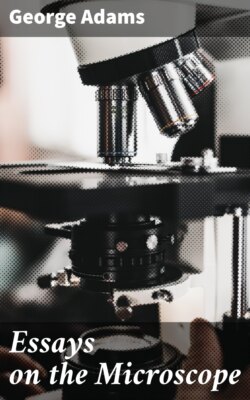Читать книгу Essays on the Microscope - George Comp Adams - Страница 26
На сайте Литреса книга снята с продажи.
APPARATUS WHICH USUALLY ACCOMPANIES THE IMPROVED LUCERNAL MICROSCOPE.
ОглавлениеThe stage, Fig. 1, f g h i, for opake objects, with its glass semiglobe, and concave mirror, which is moveable upon the bar Q R S T, and set readily to any distance by the screw at a. The glasses o and n are also moveable upon the bar for regulating and adjusting the light upon the object.
The stage, Fig. 4, for transparent objects, which fits on the upper part P S of the foregoing stage. When this is to be applied occasionally to a lanthorn for shewing transparent objects on a screen, &c. it is made of a much larger diameter, to admit of the illuminating lenses at 9, 10, and 11, of greater power of condensing the rays from the lamp.
The sliding tube O P, to which the magnifiers are to be affixed; one end of this is to be screwed on the end B of the wooden body; the magnifier in use is to be screwed to the other end on the inner tube. This tube slides inwards or outwards; it is first used to set the magnifier at nearly the right distance from the object, before the exact adjustment for the focus is made, by turning the pinion at a with Hook’s joint and handle b e.
Eight magnifying lenses in brass cells, Fig. 5. Plate III. these are so constructed that any two of them may be combined together, and thus produce a very great variety of magnifying powers. The cells unscrew to admit of the glasses being cleaned.
A fish-pan, such as is represented at Fig. 6, whereon a small fish may be fastened in order to view the circulation of its blood; its tail is to be spread across the oblong hole at the smallest end, and tied fast by means of the attached ribbon. The knob on its back is to be put through a slit hole on the brass piece, No. 5, of Fig. 4. The tail of the fish is to be brought then immediately before the magnifier.
A steel wire, Fig. 7, with a pair of nippers at one end, and a steel point at the other; the wire slides backwards or forwards, in a spring tube which is affixed to a joint at the bottom, on which is a pin to fit the hole in the leg, No. 6, Fig. 4. This is used to confine small objects.
A slider of brass, Fig. 8, containing a flat glass slider and a brass slider, into which are fitted some small concave glasses. It is for confining small living objects, and when used is placed between the two plates, No. 7, Fig. 4.
A pair of forceps, Fig. 9, by which any occasional small object may be conveniently taken up.
Six large ivory sliders, with transparent objects placed between two plates of talc, and confined by brass rings, and six small ditto with ditto. Fig. 10. The larger ones usually contain a set of Custance’s fine vegetable cuttings.
Fourteen wood sliders, containing on each four opake objects, and two spare sliders for occasional objects; all fitted to the cheeks kl of the stage. Fig. 11.
Some capillary tubes, Fig. 12, to receive small fish, and for viewing small animalcula. They are to be placed between the two plates of the stage No. 7, Fig. 4.
A small ivory double box, containing spare plates of talc and brass rings, for replacing any in the small ivory sliders, when necessary.
A single lens mounted in a tortoiseshell case, to examine minute objects previous to their being applied to the sliders.
Opake objects are easily put on the spare sliders by a wetted wafer; and, for good security, gum water may be added.
For the prices of the lucernal, as well as all the other sorts of microscopes, see the list annexed to these Essays.
